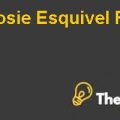Ryanair Case Study Analysis
Balance Scorecard:
Financial: The major objective of the company is to maximize its profitability of the The performance measures used to evaluate the achievement of the profit, include: profit margin, scheduled revenues and ancillary revenues. It is evaluated that the organization has achieved a profit margin of 21%, which is greater as compared to the profits generated in 2017. In addition to which, the scheduled revenue has increased by 5.4% , whereas the ancillary revenues have increased by 13.3%.Therefore, the business is advised to reduce its airport and handling charges cost, marketing and distribution cost and depreciation associated with assets.
Customer: The strategic goal of the company is to increase the number of passengers by 200 million till 2024. In order to achieve this goal; the company has improved the customers’ perspective, which is dependent on low fares and an improved quality service. It is evaluated that the company has succeeded in implementing a low pricing strategy, as its flight fares are lower in comparison to its competitors. Moreover, the strategic objective of improved customer service is evaluated on the basis of punctuality and lost baggages. The punctuality of the flights have reduced to below 70% in the year 2017, whereas, the company did have aboost in its performance by just one lost baggage per 3000 customers.Therefore, the customers appear to be satisfied with the services being provided by the company.
Internal: The internal process of the organization is evaluatedon the basis ofturnaround time and load factor. The passenger load factor for the organization has increase by 95% in 2018, indicatingto an efficient business process as the plane seats are occupied efficiently, which helps in the allocation of fixed cost over more customers. The turnaround time for the company’s flights is aligned with the industry average.Therefore resulting in the company havingan efficient business operation.
Learning and Growth: The organization thrives to learn and grow, which is evident by the increase in the services of the company in various airports i.e. (operatimg flights from 217 airports as compared to previously served 206 airports), investment in mobile phone app development and remodeling of the website. The combination of these factors has enabled the company to have a tremendous increase in its revenues which is led by an increase in the number of employees being employed in the company, indicating low employee turnover rate and a high employee morale.
Recommendation and Implementation
Based on the external and internal analysis, it is recommended to the company to focus on increasing the revenues from services, as a significant generation of revenue comes from the provision of ancillary services. This can be done by the compamyif it begins to have contracts and exclusive partnerships with shops, restaurants and secondary airports. It is evaluated that the company has achieved its financial goals, which include a rise in profit margin, scheduled revenue and ancillary revenue.
Furthermore, the company is also advised to introduce promotional offers, such as: loyalty programs to attract a maximum number of customers. The company should negotiate with the trade union and introduce fair employment practices by taking necessary steps to increase the employees’ loyalty and motivation. The company has higher possibilities of facing further reputational damage and customer dissatisfaction as a result of the flights cancellations. On the other hand, it is also advised to the company that it should increase the punctuality of flights, as delay in the flights is one of the major reasons behind passenger’s dissatisfaction and annoyance.
To conclude, last recommendation to the company is that it should hedge the currency risk and volatility in oil prices by using multiple hedging techniques, which include:future contracts, currency swaps, options and money market hedging, as the business model tends to be significantly affected by therise in the fuel prices.
Appendices:
Appendix 1 – Porter Five Forces
| Bargaining power of supplier | The bargaining power of supplier appears to be high as there were only two aircraft suppliers in the industry i.e. Boeing and Airbus. In addition, as the organization uses one single fleet for all its flights, the switching cost is high due to higher dependency on supplier. Moreover, in order to be environmentally responsible and reduce the threat of high fuel cost, the organization had to use fuel efficient aircrafts which indicates high reliance on supplier.
|
..................................
This is just a sample partical work. Please place the order on the website to get your own originally done case solution.










